The Certainty of Hazard
- amiedodgsonart
- Oct 27, 2020
- 12 min read
Updated: Jan 11, 2021
The Certainty of Hazard was a starting point, along with a similar theme from the drawing workshop of chaos and control. During my foundation I explored chance as an area of interest for me in my practice, so this workshop was suited to me and I enjoyed it.
‘How to open at will the window onto the most Beautiful landscapes in the world and elsewhere’ - Andre Breton (on Decalcomania)
“You have power over your mind - not outside events. Realise this, and you will find strength.” ― Marcus Aurelius, Meditations
The following experiments :
· Wax melting. Melt some wax and pour into cold water.
· Painting with acrylics and folding the paper in half to create a pattern/shape.
· Create your own sigil by overlaying the letters of your name, think of it as a logo.
· Automatic Drawing. Stare into the onyx and let your hand move unconsciously, a continuous line, draw the darkness.
· Mono-printing
· Marbling - creating effects with marble paints in water and dropping paper into the water to create a chance effect.
· Smoke drawing - lighting was melt and letting the smoke draw.
These were images from the process and results from wax melting.
The process was slow but once the wax was melted it was great fun. The results were really effective. I wanted to create abstract pieces that were almost alien like. The idea of chance really came into play with this one as you couldn't control the result at first. However after a bit of experimenting with the amount of wax I dropped into the water, the speed it was dropped and what I used to drop it onto, I managed to control it a little more. The wax really appealed to me due to the nature of it; at room temperature it is a solid, therefore to draw, mould and create with it it must be altered with heat chemistry. It allows light to travel through it with it being translucent and it adheres to many surfaces binding objects together. You can build textures and layers and the surfaces you bind it to can be smooth, rough, matte or glossy. From the drawing workshop I found I wanted to explore textures that would be inviting for the viewer to explore by touch. The wax as a medium would do just this and more by also exploring more than touch but other senses; smell using different flavours of wax and sight using different light sources to shine through the wax to create translucent effects and a luminescence therefore creating work that engages the senses to make it naturally unique to each individual.
I took this work further during the workshop in the afternoon by placing the wax structures into marbling inks. The results were not 100% what I was expecting. The colour palette didn't work and was too bright.
I will develop this further by experimenting more with wax and cold water; the speed I drop it into the water, the amount of wax I use and the materials I use to bind it to. I will also develop it further by creating a different colour palette for the marbling, experiment with different mediums for painting; acrylics, watercolour and natural colouring.
These were the results from painting with acrylics and folding the paper in half to create a pattern/shape. This was quite a simple exercise however I do like the results from it. The colour palette is successful and the patterns the paint made once swashed and pushed with my hand onto the folded paper.
I took these further during the workshop by adding mono printing, smoke drawing and wax melting and combining the images to create a bigger piece. The smoke drawing I liked the effect as it was quite subtle. I also thought the mono-printing on top of the below middle image was effective however I think I took it too far when I combined the images and started to add wax to it. I was experimenting and didn't really have an idea in mind whilst doing it which was a mistake as it turned out to be a failure piece. I experimented with pouring wax onto the paper and then dunking it all under water which did create the effect I was going for; I wanted it to be more textured than smooth. However it still didn't work and I think its because of the combination of the two images underneath, it didn't quite look right. To take this techniques further of combining processes I would do this on a bigger A3 sheet of paper. Do the acrylic painting first, fold, dry and then add mono-printing on top, dry and then add wax. I wanted to make it more 3D and than just a 2D piece of paper.
The results I got from combining the continuous line drawing looking into onyx and adding the acrylic painting fold on top I do quite like, however I think I could have taken the continuous line drawing much further by spending more time and scaling up. Possibly using more paint too. I do like the effect of the pencil underneath the paint however I didn't create texture.

Below, the results of the marbling effect were effective, however again, I wanted to create more texture and to make it 3D. I used one of these on the bigger image further up to pour wax onto to see what effect it would make. I scrunched the paper up and I quite liked the texture of this after making it 3D. However it didn't work in the image further up as it was completely drowned in wax.

I used the rest by experimenting with mono-printing over the top. I do like the effect of these however I used my ring to draw and feel that a sharper end may have got a more effective result.
Doing a more intricate design over the top would be something I would like to take further with this technique.
The last one I added layers of wax over the top to build it up and make it more 3D.
I liked this however again, I would like to take this further by scaling up and as this was only an A5 piece, or doing more A5 pieces and attaching them together somehow and making a 3D sculpture to create some texture.

The other technique I used was mono-printing. I was surprised at how effective these were as mono-chrome images. The lines were drawn using my ring and the heavier, darker parts I used the palm of my hand and my fingers. I like how different tools create varying tones.

I furthered this during the workshop in the afternoon by adding the acrylic folding process on top of one of them. This was the result. I like the pop of colour added and the colour palette I used. I didn't really have anything in mind whilst doing this either, it was more of an experimentation to see how the effect of folding the paper and mirrored paint effect would have over the mono-printing. Its very abstract which I like, however I am wanted to create more textures to my pieces.

I made a sigil by overlaying the letters of my first name and then my surname. I really liked this and I want to take this further by taking it into illustrator and transforming it into a logo for myself.

Lastly I made these using the smoke drawing technique. I loved how unpredictable these were but also had an element of control over the tones depending on how long I held the paper on the fire; longer for darker tones and shorter for lighter tones. I want to develop these further by experimenting using alcohol inks and black pen drawings over the top as the alcohol inks give a similar effect. I will see how these relate to each other. It could also create texture which is what I am enjoying experimenting with in my practice at the moment.

The experiment was creating a painting from a curse & prayer on A3.
This one is a curse.

This one a prayer.

The medium used for these was cider vinegar. I loved the colour it made on the paper and how it made the paintbrush feel when making marks.
I closed my eyes to make both of them. When doing the prayer one I said the serenity prayer, a prayer I have used often over the last 4 years at times when I have needed it.
Both of them remind me of Japanese symbols.
With the curse one there is a lot more charge to the brushstrokes, whereas the brushstrokes are more delicate and light with the prayer one.
I would like to further the material of using cider vinegar more by using different tools to make marks with. I like the colour of it and would like to test it out on different materials.
Developing Ideas - Wax at home

Furthering on from the workshop I wanted to experiment more with melting wax and dropping it into cold water. I wanted to explore it like a science project, testing the speed in which I drop it into the water, the amount and what I used to drop it in with/onto.

I set up the space with my trusty purple bucket filled with water, ladle, pad and pen, paper to rest the wax onto, wax and saucepan over heat to melt the wax in.

The first two I poured slowly using a ladle, they came out pretty similar to the ones I did in the studio in the workshop. I like the form and texture of the one on the left.
For these ones I poured a lot more wax. For the larger one I wanted to create a landscape so poured it really slowly then splashed water on top of it which formed the textures on top which I thought were effective. The other I poured faster which seemed to create more ball like forms on the piece.

I moved on to using moulds. These are poached egg silicone cups that I felt would be easy to slip the wax on and off without it sticking to the mould.
I dunked them using my hands at varying speeds. The faster I dunked the shorter the form. The faster I dunked the taller the forms became.
These ones were dunked a lot slower. I like them but they haven't worked as well, aesthetically as the first set.
This is documentation of me doing it.
These ones were varying in dunk speeds too and you can tell from the shape of them.
1) slow dunk
2) fast dunk
3) medium dunk.
This is a video of the process.
For developing these wax sculptures I would like to experiment using different paints and colours on them and try videoing and photographing them in various places to see how the varying backgrounds would change the view of the pieces.
Developing Ideas Further
The idea behind this work was to look at creating something engaging for the viewer. An insight into the process but also try re create a physical representation of emotions. The starting piece for this work came from the alcohol ink painting I made.

To begin with, I thought I couldn't take it much further with it being just alcohol ink on YUPO paper, however the more I reflected on it the more I wanted to explore how I could re create the painting as a sculpture. The thinking process for this was to explore emotions in relation to music, how they both invoke physical responses in the body and then to materialise this process with the use of colour, water, and wax.






I materialised the emotions first with cellophane after taking inspiration from Karla Black's sculpture using found materials and objects. I like the idea of using non art materials as well as art materials.
Below is the result of the sculpture I made in the studio.
I started with using paper, but felt it didn't work. The paint was too heavy for what I wanted. I wanted to have the thin layer of paint on the cellophane to experiment with light being able to pass through.
A time lapse of the process...
A close up of one of the pieces...
Reflections:
- The cellophane worked well as a material. It was easy to manipulate into the shape I wanted.
- The acrylic worked well as a paint for the cellophane, it gave a thin layer without it looking too heavy and gave a pastel type colour which is what I was looking for.
- It was a good representation of the painting however I wanted to extend and scale up.
-- I would like to try using wax and make some modular shapes that i can build and mould into a larger scale sculpture.
- The only issue that I had was that I has to use masking tape to stick it to the sides of the walls in the studio space - I need to think about another way I can re build this at home, without having to use the studio walls, and be able to travel with it to transport it for the studio crit in January.
- When it came to being able to see through the cellophane and experiment with light, this wasn't very obvious. I would need to experiment with different lighting techniques to light the piece.
Setting up for Wax experiment developments part 2
I ordered a glass tank online after being inspired by Pascal Smelik's videos of him pouring melted wax into cold water and capturing the process using a glass tank. Below is the video that inspired me. This video was made by Smelik to show to process of creating a series called 'Kaarsrecht'.
Paul Smelik - Kaarsrecht series
Smelik is a designer and his exploratory work aims to expand the contemporary notion of design. His objects are set apart by his fascination for the growth, distortion and fusion of natural phenomena and their processes. He navigates between art and design and his processes lead to spectacular but bizarre design methods. Smelik creates work that recalls nature and growth in the abstract. His inspiration for the Kaarsrecht series was the idea of deformity. He wanted to see if he could find beauty in deformed natural elements despite negative connotations. He brought this vision to life by simulating melted candles using aluminium and bronze. In addition to the above pieces, Smelik also created glasses as a part of the Kaarsrecht series.
Following on from my own work, the wax melting I had done in previous experiments and the alcohol ink painting through to sculpture. I wanted to combine the 3 elements; Using the wax melting with alcohol inks to create a sculpture and to video the process and edit it along to music to see what questions/feelings it evoked for me, and the create engaging video inspired by the works of Smelik.

A video of the process by Amie Dodgson - music by Bonobo
These are stills from the first experiment of mixing the alcohol ink with the wax. I experimented with dropping the alcohol ink onto the surface of the water first. These were ok, I wanted to push it further by scaling up. I needed to find a way of doing this.
I went on to make a bigger piece which was much more engaging. The alcohol ink mixing with the wax was effective, it made the colours translucent and opaque. There is a textural quality to the wax which is interesting and alien-like. Photographing it from different angles makes it look like a completely different piece so thinking about it in an exhibition space I would need to think about a plinth to rest it on so it could be viewed from all angles.
I wanted to combine the first piece and the second piece to make it even bigger. So I placed them both into the water and poured more melted wax in between them to join them together. This time I experimented with dropping the alcohol ink onto the wax once it was in the water. This gave an even brighter colour to the wax which was interesting. It seemed to combine into the wax more.





This image in particular looks like a cows face, which is interesting as some of the feedback I had from peers said it actually looked like a cows stomach.
Some other feedback I had from peers:
Coral/ coral reef form

Fractals – funky green spiky looking broccoli

A cow’s stomach

Modular – several small models can be made and then attached/ melted/ morphed together to form a larger scale piece
After this experiment I researched more artists that use wax in their work and came across this artist:
ZHENG GUOGU

'Waterfall' by Zheng Guogu 2003 Collaborative work with the Yangjiang group inc. Chen Zaiyan and Sun Qinglin
Wax, calligraphy, metal armature 210 x 140 x 140 cm
Guogu’s work combines materials with unorthodox and fragile substances, the physicality of the forms operate as tactile and symbolic matter. In this piece, 'waterfall' , he pours melted wax over a metal ballast, which freezes in motion, and embeds calligraphy scripts in the fountain of wax. It suggests a mountainous landscape. It is both monumental and illusory, and creates a harmonious tension between permanence and temporality. According to Saatchi Gallery, ethereal whiteness in Chinese culture signifies grief and mourning.
- To push these experiments further I would like to try combining other materials within the wax, taking inspiration from Guogu's 'waterfall', where he uses scriptures.
Reflections on the video of wax falling into water:
Diving under ice – Werner Herzog’s Encounters at the end of the world – the under-water scenes.

(still from W.Herzog's film, 'Encounters at the end of the world'.)
From these experiments I have come to cement a realisation that I have a keen interest in colour and process and how colour ink merges into wax. The concept that I began with was materialising emotions by combining different media. This was not realised however these experiments have inspired other concepts to explore such as the Anthropocene in relation to coral reefs and nature's phenomena.



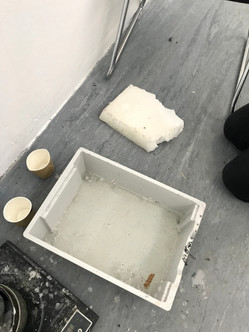








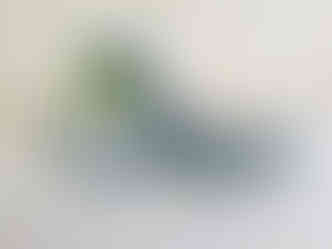


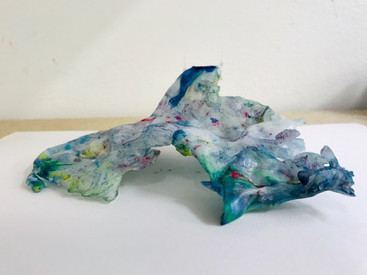

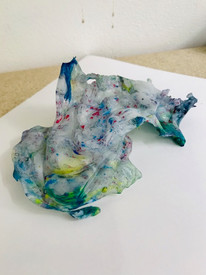







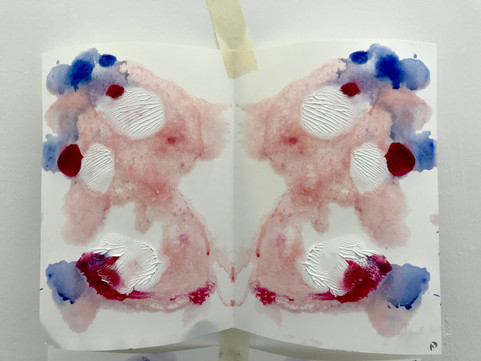







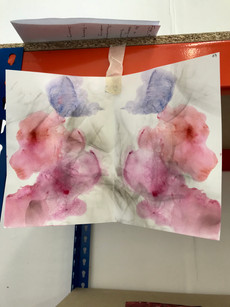



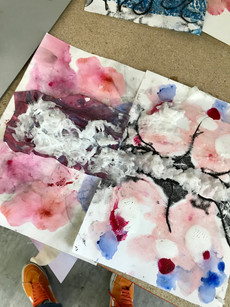







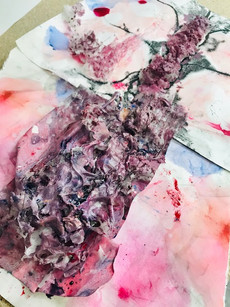




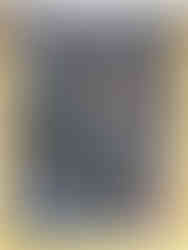
















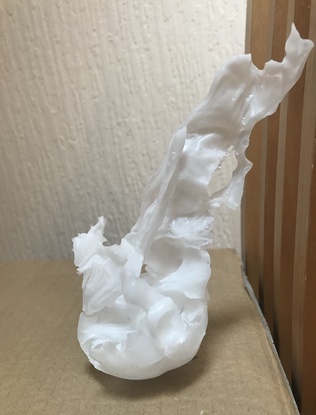

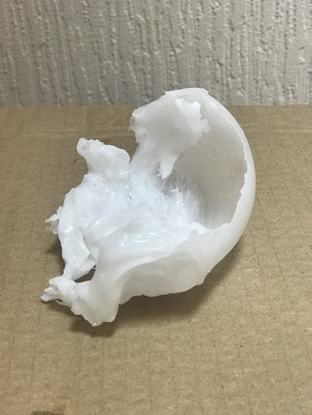































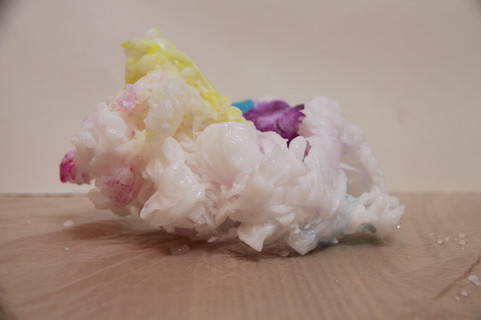







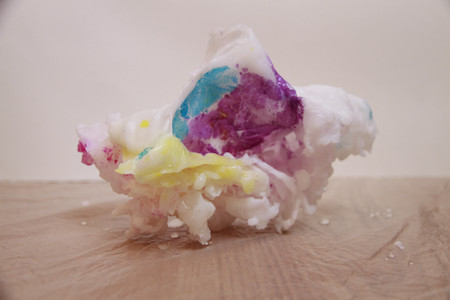











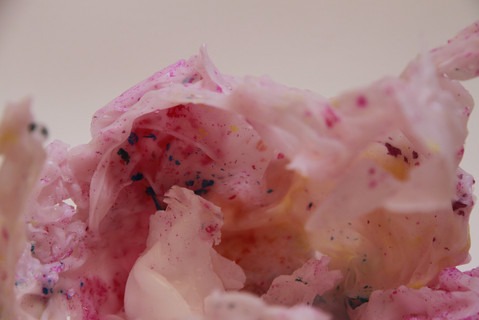
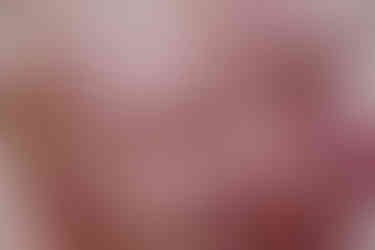

Comments